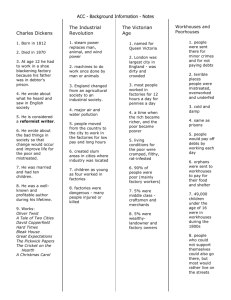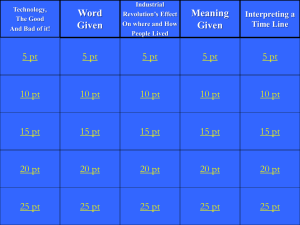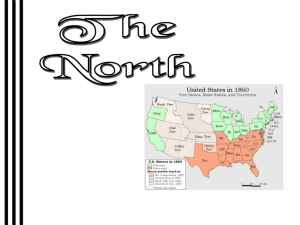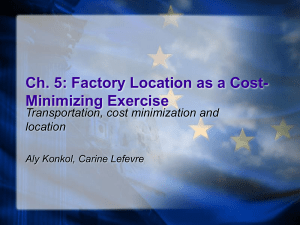The Market for Training Services: A Demand Experiment with By M
advertisement
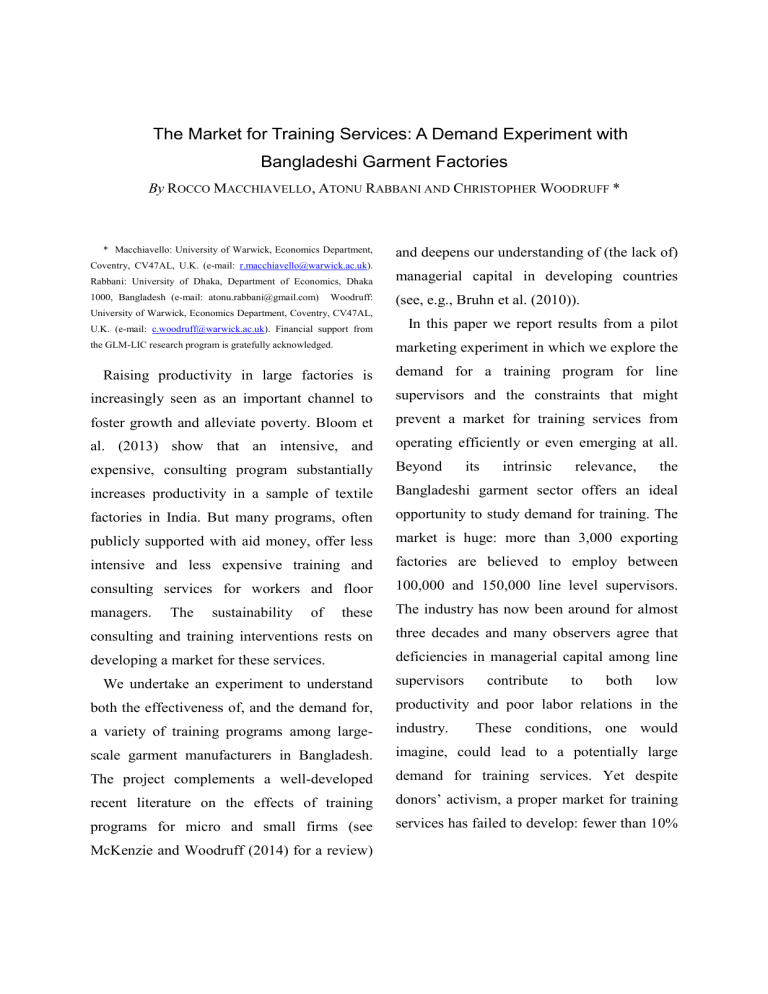
The Market for Training Services: A Demand Experiment with Bangladeshi Garment Factories By ROCCO MACCHIAVELLO, ATONU RABBANI AND CHRISTOPHER WOODRUFF * * Macchiavello: University of Warwick, Economics Department, and deepens our understanding of (the lack of) Coventry, CV47AL, U.K. (e-mail: r.macchiavello@warwick.ac.uk). Rabbani: University of Dhaka, Department of Economics, Dhaka 1000, Bangladesh (e-mail: atonu.rabbani@gmail.com) Woodruff: managerial capital in developing countries (see, e.g., Bruhn et al. (2010)). University of Warwick, Economics Department, Coventry, CV47AL, U.K. (e-mail: c.woodruff@warwick.ac.uk). Financial support from the GLM-LIC research program is gratefully acknowledged. In this paper we report results from a pilot marketing experiment in which we explore the Raising productivity in large factories is demand for a training program for line increasingly seen as an important channel to supervisors and the constraints that might foster growth and alleviate poverty. Bloom et prevent a market for training services from al. (2013) show that an intensive, and operating efficiently or even emerging at all. expensive, consulting program substantially Beyond increases productivity in a sample of textile Bangladeshi garment sector offers an ideal factories in India. But many programs, often opportunity to study demand for training. The publicly supported with aid money, offer less market is huge: more than 3,000 exporting intensive and less expensive training and factories are believed to employ between consulting services for workers and floor 100,000 and 150,000 line level supervisors. managers. these The industry has now been around for almost consulting and training interventions rests on three decades and many observers agree that developing a market for these services. deficiencies in managerial capital among line The sustainability of We undertake an experiment to understand supervisors its intrinsic contribute relevance, to both the low both the effectiveness of, and the demand for, productivity and poor labor relations in the a variety of training programs among large- industry. scale garment manufacturers in Bangladesh. imagine, could lead to a potentially large The project complements a well-developed demand for training services. Yet despite recent literature on the effects of training donors’ activism, a proper market for training programs for micro and small firms (see services has failed to develop: fewer than 10% McKenzie and Woodruff (2014) for a review) These conditions, one would of existing supervisors have received any buyers sourcing from the factory (a weighted formal training. average of unit prices paid by buyers in the market), quality (the residual of a simple logit I. Set-Up and Experiment demand estimation).2 We partner up with a local service provider Working with the LSP and GIZ, we (LSP) to market a training program to garment produced a high-quality bilingual brochure factories. The curriculum of the training and professional video describing the training program was developed by local training program. Each factory was then approached centers and GIZ, the German Technical by phone by a trained member of staff Cooperation Agency, with a long history and a working for the LSP. A trained enumerator good reputation in the sector. The training recorded information from the phone call and consisted of six days of training for existing from the overall marketing process. line supervisors. Three modules with self- Factories were told that the LSP was contained curricula were offered: production running a campaign to increase awareness of planning and processes (P), processes to its training services, offering training at a enhance quality (Q), and HR practices, discount. Each factory was offered to purchase leadership and social compliance (H). slots in training sessions at randomly selected Using transaction-level customs records we prices. The offered prices ranged from constructed a sample of 632 exporters in approximately 60% to 100% of the estimated Dhaka.1 We matched the names of the full cost of offering the program. In addition, factories with a number of directories to the factories were offered a free slot in a obtain contact details of the factories. We randomly selected module (P, Q, H) to allow were able to find current contact information them to test the suitability of the program.3 for 288 factories. Using the customs data, we II. Results also categorized factories as above or below median according to three characteristics: size We are interested in three main outcomes: i) (measured in export revenues), quality of whether, conditional on establishing contact 2 1 There are 1433 exporters operating in Dhaka for the relevant period. We trimmed the sample to focus on exporters accounting for 95% of exports volumes across all products in the 27 largest destination markets. We excluded exporters we had worked with to evaluate the training programs. 3 Further details on these variables are available upon request. Since the training is conducted outside the factory at facilities run by the LSP, the free module was intended to allow factories to learn not only about the “quality” of the training, but also about other practical aspects, such as convenience of the location and teaching hours. with the factory, the factory accepted an offer 120 requested additional information. Column to send additional information by mail; ii) II shows that the modules P and Q have a 15% whether the factory took up the free slot, iii) higher chance of leading to a request for questions raised by factories and reasons for additional information. The effect of price is refusing the additional information and/or the negative, but small and very far from being free slot offer. statistically significant. Column III explores interactions between A. Demand for Additional Information on the Training Program the price offered and the module offered for the free-slot. We find a negative elasticity of Table 1 reports results. A factory is additional information being requested with considered to have been reached only if we respect to prices when the H module is could deliver the sales pitch to a decision offered, but not when the P and Q modules are manager (henceforth DM), typically the HR offered. manager. Out of 288 firms in the sample, we Column IV the explores price the offered interactions reached 183 DMs and delivered the pitch in between and firm 135 cases. Column I shows that, although the characteristics. There is a negative elasticity chance of being reached is slightly higher with respect to prices, but not for firms that when the free-slot is offered in the Q model are larger or that have higher quality buyers. and is lower for large firms, the treatment In sum, the first stage of the marketing variables and the firms characteristics do not reveals that there is a lower and more elastic jointly predict whether a firm was reached or potential demand for the training module in not (F-test 1.46, p-value 0.19). Consequently, HR practices and social compliance and a the remaining of the analysis focuses on the somewhat less elastic demand for larger firms 135 firms we reached.4 and firms exporting to higher quality buyers. Columns II to IV consider whether the B. Take-Up of the Free Slot factory asked to be sent additional information on the training. Of the 135 reached factories, The marketing material was sent to the 120 factories that demanded additional 4 For the factories with whom we could reach a decision maker but couldn’t deliver the pitch, the main reasons were (multiple codes allowed): 33% decision maker is too busy, 35% cases we were referred elsewhere, 7% of cases the call dropped for technical reasons, 3% pitch was interrupted, 17% not interested, 22% other sparse reasons (e.g., manager is on a trip, training curriculum not relevant for the factory, etc.) information. In a follow-up phone call, we tried to re-establish contact with the factories to offer of the free slot. Columns V to VIII report the results. Out of We have records for 135 conversations during the 120 factories that requested additional the first call and for 78 conversations at information, we were able to have a second follow-up. conversation with only 86. There is evidence Points of Discussion.— Figure 1, left panel, that decision makers could be more easily describes the points of discussion in both the reached when the free-module offered was P first and follow-up calls. We code twelve and in larger factories. Although the linear aspects we intended to cover during the sale relationship is not statistically significant, pitch. higher prices tend to be associated with a introduction to the local service provider, the higher likelihood of being able to talk again curriculum of the various modules, discussion with the decision maker (Column V). Only 16 of the initial free-slot offer as well as other factories – 19% of those reached on the practical details. The figure shows that, while second call, but less than 6% of the initial the essential information was covered in sample – took up the free slot. Columns VI to almost all calls, intended beneficiaries and the VIII explore drivers of the decision to take-up training method were less likely to be covered. the free slot on the sample of factories we Significantly less information was exchanged could contact with the first call (Column VI), during the follow-up call than in the initial the sample requesting additional information call. These include, among others, (Column VII), and the sample we were able to Questions Raised.— We also recorded the contact at follow-up (Column VIII). In all questions asked during these conversations by specifications we find no effect of the the factories (see Right Panel of Figure 1). treatment variables, including prices, on take- Two patterns emerge. First, with the exception up of the free slot. There is some indication of questions pertaining to the credentials of that larger firms are more likely to take-up the the local service provider, many more free slot. questions were asked in the follow-up call than in the introductory call.5 Second, relative C. Points of Discussion, Questions and Reasons for Rejecting the Offer Throughout the process, we recorded the points of discussion, the questions raised and the reasons given for turning down an offer. to practicalities and administrative issues, questions regarding curriculum of modules offered or even pricing were less common. 5 This is not entirely driven by less interested factories dropping out at follow-up: the comparison holds true when conditioning on factories reached at follow-up. In general, phone calls in which more Reasons for Rejecting the Offer.— In questions were raised are far more likely to general, scheduling a conversation with the result in a positive outcome: a request of decision maker was difficult. In most cases information during the first call and taking up (33% at first call and 87% at follow-up) the the free-slot at follow-up. This is true not just decision maker was said to be too busy.6 For considering all questions taken together, but 40 firms, we were able to code the reasons for also for specific dimensions. For example, six definitively rejecting the offer at either the types initial call (15 firms) or at follow-up (25 of Practicalities, questions Scheduling, (Participation, Free Module, firms). For simplicity, we bundle the Pricing, Approval from Superior) correlate responses at the two different stages. The with a positive outcome in the initial call, and following reasons, ranked by importance, eight dimensions (Resources, Module P, were mentioned as the reason the additional Training Method, Participation, Practicalities, information or free-slot was turned down: 1) Scheduling, Free Module, Administration) Production pressure is too high (25%); 2) correlate with taking up the free slot at follow- Factory is unable to spare supervisors (20%); up. There are two notable exceptions: 3) DM does not believe training would be questions about training certificates to be effective (15%); 4) the factory is unwilling to issued to workers and concerns over trainees train supervisors outside its premises (15%); leaving the factory once the training is 5) migration concerns, i.e., trained supervisors completed correlate with a lower likelihood of will leave the factory after completing the a positive outcome at both stages. training (10%); 6) training is too long. It is In general, treatment variables (price and interesting to note that only two factories free module) and firm characteristics do not (coded as selling to higher quality buyers) explain much of the variation in the number or mentioned they already offered training to type of questions raised during the initial or supervisors and only one factory mentioned follow-up call. There is some evidence that the training was too expensive. Conditional on firms supplying buyers paying higher prices refusal, factory characteristics do not explain asked fewer questions at both stages. A higher much of the variation in the reasons given for price leads to more questions at the follow-up turning down the free slot. stage (the correlation is negative, but not 6 statistically significant at the initial call). The lower percentage in the initial call is explained by the fact that many calls had to be used to locate the appropriate decision maker. the program close to a commercially viable III. Conclusions rate, this suggests that, in principle, it could be We set out to market a training program for lower level managers (line supervisors) to large factories in the Bangladeshi ready-made garment industry. The program was offered by an established local service provider and developed by a reputable Technical Cooperation agency with a long experience in the industry. The program was tailored to the needs of garment factories, as assessed during the enrollment phase of a different program that trained predominantly female line operators to become line supervisors (see, Macchiavello et al. (2014)). possible to develop a market for such training services – provided they could be proved to be effective. Third, there appeared to be higher interest and demand in training modules aimed at improving production processes and quality, rather than human resources and social compliance – despite the fact we marketed the program mostly to human resource managers. Evidence is lacking on the relative merits of these two types of programs. A priority for future research is to assess how the demand for this type of programs is influenced by A number of results emerge. First, take-up of the program – even for a free slot – was very low. Qualitative information coded during the initial interactions with the factories, suggests that intense production experience with the program as well as with more rigorous information on their effects. Research to evaluate the effects of this training program on a sample of comparable factories is currently underway. pressures are an important reasons for the low demand. High production pressures are IV. REFERENCES somewhat intrinsic to the industry in which just-in-time, short lead-time and reliability in deliveries are key sources of comparative advantage, but are exacerbated by an environment characterized by frequent shocks. Managers high up in the factory hierarchy, such as Human Resource Managers, then, appear to be engaged in constant fire-fighting. Second, take up of the program appear to be quite insensitive to pricing. Since we did price Bloom, Nicholas, Benn Eifert, Aprajit Mahajan, David McKenzie, and John Roberts. 2013 “Does Management Matter? Evidence from India.” The Quarterly Journal of Economics 128, no. 1 (2013): 151. Bruhn, Miriam, Dean Karlan, and Antoinette Schoar. “What developing capital is countries?” The missing in American Economic Review (2010): 629-633. 48-82. McKenzie, David, and Christopher Woodruff. Macchiavello, Rocco, Andreas Menzel, and "What are we learning from business Chris Woodruff. 2014 “Managerial Capital training and entrepreneurship evaluations and Productivity: Evidence from a Training around the developing world?" The World Program Bank Research Observer 29, no. 1 (2014): Sector”, mimeo Warwick. in the Bangladeshi Garment V. Tables and Figures TABLE 1 Initial Call Reached I Price II 0.0097 (0.0146) 0.0525 (0.0711) 0.138 (0.072)* -0.0628 (0.0587) 0.0359 (0.0588) -0.1062 (0.0586)* Module P Module Q Higher Demand Better Buyers Larger Firms Follow-Up Call Info Requested III -0.0201 (0.0128) 0.1506 (0.066)** 0.161 (0.064)** -0.0844 (0.0528) 0.0588 (0.0527) 0.0709 (0.0528) Module P X Price Module Q X Price -0.0800 (0.024)*** -0.8032 (0.3562)** -0.6720 (0.3493)* -0.0860 (0.0516)* 0.0525 (0.0514) 0.0664 (0.0517) 0.0866 (0.032)*** 0.0760 (0.0316)** Higher Demand X Price IV -0.0547 (0.0261)** 0.1485 (0.0657)** 0.1457 (0.0647)** 0.092 (0.280) -0.4125 (0.2809) -0.3472 (0.2814) Reached V VI Free Slot Take-Up VII VIII 0.023 (0.020) 0.202 (0.102)** 0.064 (0.100) -0.078 (0.082) 0.117 (0.081) 0.159 (0.082)* 0.020 (0.014) 0.009 (0.070) 0.0503 (0.0686) -0.043 (0.056) 0.038 (0.056) 0.112 (0.056)** 0.024 (0.015) -0.019 (0.081) 0.0275 (0.0790) -0.032 (0.063) 0.031 (0.063) 0.112 (0.062)* 0.019 (0.020) -0.030 (0.109) 0.0570 (0.0115) -0.051 (0.088) 0.027 (0.088) 0.121 (0.086) 2.25 0.05 135 1.38 0.02 135 1.20 0.01 120 0.75 -0.02 86 -0.0153 (0.0253) 0.0430 (0.0255)* 0.0376 (0.0255) Better Buyers X Price Larger Firm X Price F-test Adjusted R2 N observations 1.46 0.01 288 2.73 0.07 135 3.20 0.12 135 2.42 0.09 135 ***, **, * Significant at 1, 5 and 10 percent level. Price is randomly offered price (either 8500, 9250, 11625 or 14000 Bangladeshi Taka (1 U.S. $ = 78 BDT)). Module P (production processes) and Q (quality control) refer to randomly offered free-slot (omitted category module H, human resources and social compliance). Higher demand =1 if the firm is above the median in the sample w.r.t. a residual from a logit demand estimation (details available upon request). Better buyer = 1 if the firm is above the median in the sample w.r.t. a weighted average of the unit prices paid by its buyers in the market. Larger firms = 1 if the firm is above the median w.r.t. export revenues in the sample. Column I is on the whole sample. Columns II-VI are on the sample of firms that were reached. Column VII is on the sample of firms that requested information after the first call. Column VIII is on the sample of reached firms among those. FIGURE 1 Discussion Points Questions Raised LSP Credentials Resources Module P Module Q Module H Training Method Participation Faculty Credentials Benefits Effectiveness Practicalities Scheduling Free Module Pricing Migration Certificate to Workers Administration Approval from Superior LSP Credentials Introduction Purpose Module P Module Q Module H Method Beneficiaries Duration Location/Facilities Testimonials Free-Module 0 .2 .4 .6 % Calls Issue Discussed First Call .8 Follow-Up 1 0 .2 .4 .6 % Calls Question Raised First Call .8 Follow-Up The figure describes Discussion Points (Left Panel) and Questions Raised (Right Panel) during 135 completed first call and 86 completed follow-up calls. Both discussion points and Questions Raised had been pre-classified into the reported categories following extensive piloting.
